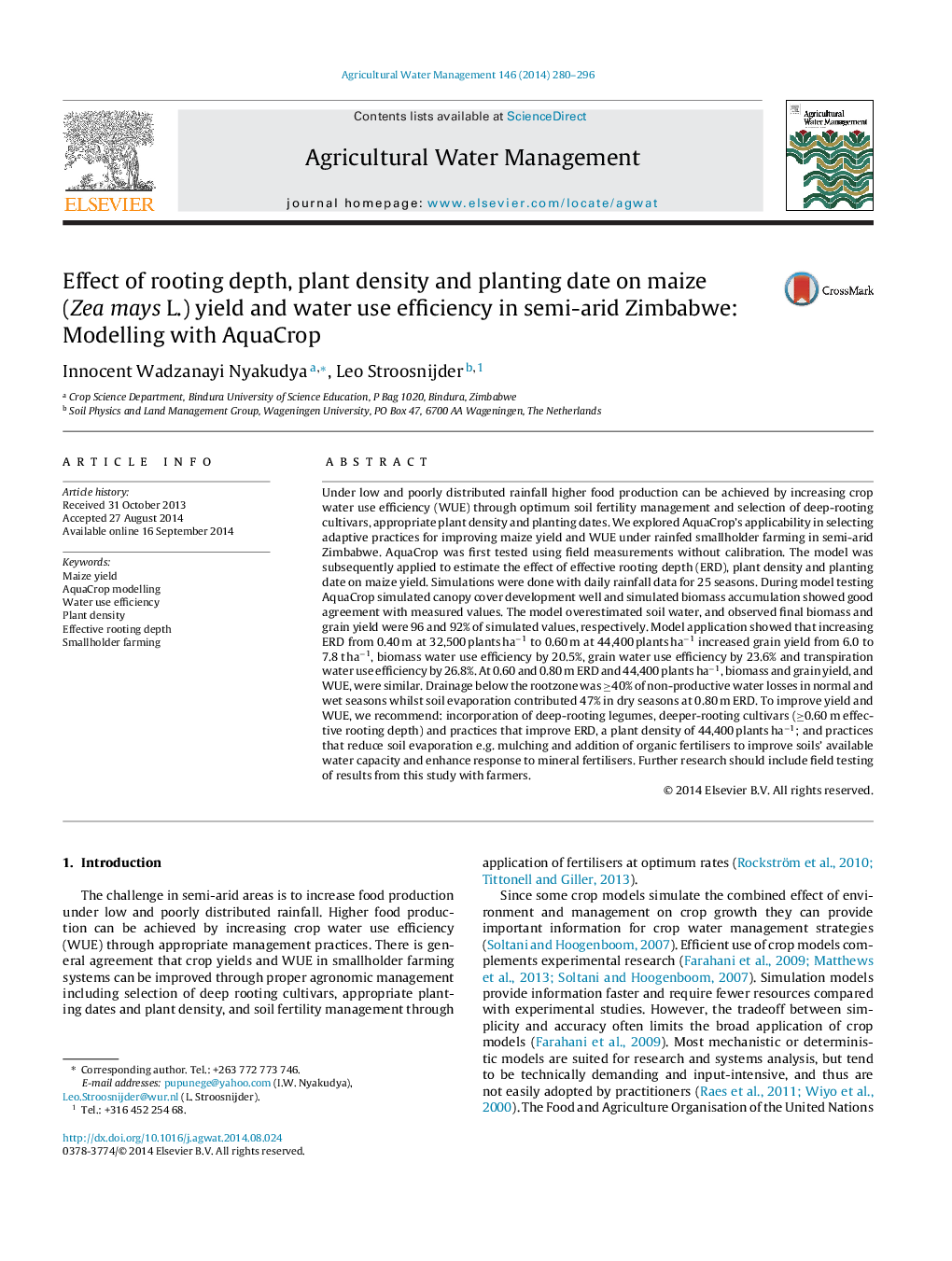| کد مقاله | کد نشریه | سال انتشار | مقاله انگلیسی | نسخه تمام متن |
|---|---|---|---|---|
| 6363973 | 1622933 | 2014 | 17 صفحه PDF | دانلود رایگان |
عنوان انگلیسی مقاله ISI
Effect of rooting depth, plant density and planting date on maize (Zea mays L.) yield and water use efficiency in semi-arid Zimbabwe: Modelling with AquaCrop
دانلود مقاله + سفارش ترجمه
دانلود مقاله ISI انگلیسی
رایگان برای ایرانیان
کلمات کلیدی
موضوعات مرتبط
علوم زیستی و بیوفناوری
علوم کشاورزی و بیولوژیک
علوم زراعت و اصلاح نباتات
پیش نمایش صفحه اول مقاله

چکیده انگلیسی
Under low and poorly distributed rainfall higher food production can be achieved by increasing crop water use efficiency (WUE) through optimum soil fertility management and selection of deep-rooting cultivars, appropriate plant density and planting dates. We explored AquaCrop's applicability in selecting adaptive practices for improving maize yield and WUE under rainfed smallholder farming in semi-arid Zimbabwe. AquaCrop was first tested using field measurements without calibration. The model was subsequently applied to estimate the effect of effective rooting depth (ERD), plant density and planting date on maize yield. Simulations were done with daily rainfall data for 25 seasons. During model testing AquaCrop simulated canopy cover development well and simulated biomass accumulation showed good agreement with measured values. The model overestimated soil water, and observed final biomass and grain yield were 96 and 92% of simulated values, respectively. Model application showed that increasing ERD from 0.40 m at 32,500 plants haâ1 to 0.60 m at 44,400 plants haâ1 increased grain yield from 6.0 to 7.8 t haâ1, biomass water use efficiency by 20.5%, grain water use efficiency by 23.6% and transpiration water use efficiency by 26.8%. At 0.60 and 0.80 m ERD and 44,400 plants haâ1, biomass and grain yield, and WUE, were similar. Drainage below the rootzone was â¥40% of non-productive water losses in normal and wet seasons whilst soil evaporation contributed 47% in dry seasons at 0.80 m ERD. To improve yield and WUE, we recommend: incorporation of deep-rooting legumes, deeper-rooting cultivars (â¥0.60 m effective rooting depth) and practices that improve ERD, a plant density of 44,400 plants haâ1; and practices that reduce soil evaporation e.g. mulching and addition of organic fertilisers to improve soils' available water capacity and enhance response to mineral fertilisers. Further research should include field testing of results from this study with farmers.
ناشر
Database: Elsevier - ScienceDirect (ساینس دایرکت)
Journal: Agricultural Water Management - Volume 146, December 2014, Pages 280-296
Journal: Agricultural Water Management - Volume 146, December 2014, Pages 280-296
نویسندگان
Innocent Wadzanayi Nyakudya, Leo Stroosnijder,